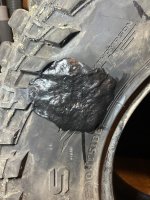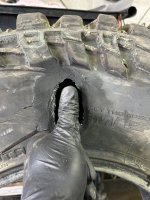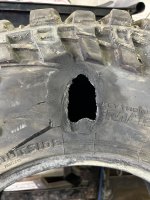Quick Backstory, I'm 4th Generation Tire guy. I started working for the family business rolling recaps at the age of 14. Re-treaded on and off for the next 10 years working from Tire Patcher to Truck Driver. I've worked with OE manufacture's with patch development and testing.
Rules for Tire patching.
1. While grinding you will get dirty. DO NOT TOUCH any part of the glue or patch area with your Richard Beaters at any time. Period.
2. Put the patch on the inside of the Rim, towards the buggy, after the patch.
I'll be adding to this vocab when I remember more.
1. Tire terms
A-B Rubber: 2 part self vulcanizing rubber. Sold in bulk as a single rope that you mix with raw rubber. BK on top. Industrial on the bottom.
Cement: Normally non self vulcanizing cement. You can get self vulcanizing, but It doesn't make the strongest bond IMHO.
Chamber: Industrail Pressure Cooker (Autoclave)
Extruder: A heated screw gun to melt and force raw rubber down into a repair area. Generally 110v and based on an air drill. Here
Heptane: Tire cleaning/ prep chemical or Store bought. Rubber Prep
Patch: A rubber and Cord lasagna. Different patches are using diffent directions of cord fibers to match Bias and Radial. It is important to use the right patch.
Raw rubber: Any rubber added during repair. Rope rubber or Cushion Gum. (Cushion gum is great to keep something from rubbing!)
Section Repair: Patch where you remove cords to make room and find the end of the cut cords of the tire.
Stone: Tire buffing stone.
Spotter: A smaller tire press with heater.
Spot Repair: Patch where you do not remove cords. Generally a smaller patch.
2. Rules of Tire patching.
The natural oils on your hands will interfere with the glue. This is why 80% of patches, that I get to fix, have an issue with. Don't touch the underside of the patch or the glue.
The Patch edge must be showing. That ring around the outside of the patch is there to help hold the air seal and is a check to see if it was repaired correctly.
Let the Tire dry 12 hours in a heated enviroment before patching. Remove all water/trash the day before. Tires patch better when hot. If the tire has been sitting in the snow and mud, the water can evaporate out of the rubber pores and effect the chemical reaction. I generally let them set in the sun for a couple of hours. Some people recommend 24 hours, but I think this is overkill.
Store your patching material in a cool dark place. Air conditioned 70 degrees works best. Any heat will start the vulcanizing process on patches and cement.
3. Thoughts on Glue Treads and external repairs.: Although never dealing with them. I really like what they have. It looks like a great product and has a practical use for Offroad recovery and LIGHT DUTY use. I don't know what exactly they are using for an adhesive and accelerator, but with my experience in the tire world, the glues will start to cure after the bottles hit 85-90 degrees. If you are using them everyday, like in a manufacturing setting, its fine to let the cure a little bit, but set them in a rig untouched and with a year they will start to degrade (Glue tread says 2 years on their Site ). Their patch is not DOT approved, nor will they sell a DOT option in the future. When we did a spot or section, we would stap OUR Manufacture's DOT brand on it. I bet that thier patch is safe and would pass a DOT, however you can never predict how someone will be applying it in the field.
4. A-B Compound, (aka BK's kit, Self Vulcanizing): A-B compound is absolutely amazing. Its primary use is for tires that are too large to go into our spotter or in the chamber. Think large earth moving equipment. Tires with thick sidewalls that need the stiffest rubber help support the phyical weight of the machine and won't flex. The prep is the same as a normal patch, but you sit there and mix the rubber with an extruder like you would with a 2 part Epoxy. Its recommend that you patch the inside to help make the repair last longer, but isn't required on some tires. A-B compound is like welding 1/4" steel plates on the side of a 1" plate if done incorrectly. The repair is going to break at the welds unless it's supported correctly.
Picture from Great Grandad's original store, circa 1953,

Edit #1 added link to AB compounds
Rules for Tire patching.
1. While grinding you will get dirty. DO NOT TOUCH any part of the glue or patch area with your Richard Beaters at any time. Period.
2. Put the patch on the inside of the Rim, towards the buggy, after the patch.
I'll be adding to this vocab when I remember more.
1. Tire terms
A-B Rubber: 2 part self vulcanizing rubber. Sold in bulk as a single rope that you mix with raw rubber. BK on top. Industrial on the bottom.
Cement: Normally non self vulcanizing cement. You can get self vulcanizing, but It doesn't make the strongest bond IMHO.
Chamber: Industrail Pressure Cooker (Autoclave)
Extruder: A heated screw gun to melt and force raw rubber down into a repair area. Generally 110v and based on an air drill. Here
Heptane: Tire cleaning/ prep chemical or Store bought. Rubber Prep
Patch: A rubber and Cord lasagna. Different patches are using diffent directions of cord fibers to match Bias and Radial. It is important to use the right patch.
Raw rubber: Any rubber added during repair. Rope rubber or Cushion Gum. (Cushion gum is great to keep something from rubbing!)
Section Repair: Patch where you remove cords to make room and find the end of the cut cords of the tire.
Stone: Tire buffing stone.
Spotter: A smaller tire press with heater.
Spot Repair: Patch where you do not remove cords. Generally a smaller patch.
2. Rules of Tire patching.
The natural oils on your hands will interfere with the glue. This is why 80% of patches, that I get to fix, have an issue with. Don't touch the underside of the patch or the glue.
The Patch edge must be showing. That ring around the outside of the patch is there to help hold the air seal and is a check to see if it was repaired correctly.
Let the Tire dry 12 hours in a heated enviroment before patching. Remove all water/trash the day before. Tires patch better when hot. If the tire has been sitting in the snow and mud, the water can evaporate out of the rubber pores and effect the chemical reaction. I generally let them set in the sun for a couple of hours. Some people recommend 24 hours, but I think this is overkill.
Store your patching material in a cool dark place. Air conditioned 70 degrees works best. Any heat will start the vulcanizing process on patches and cement.
3. Thoughts on Glue Treads and external repairs.: Although never dealing with them. I really like what they have. It looks like a great product and has a practical use for Offroad recovery and LIGHT DUTY use. I don't know what exactly they are using for an adhesive and accelerator, but with my experience in the tire world, the glues will start to cure after the bottles hit 85-90 degrees. If you are using them everyday, like in a manufacturing setting, its fine to let the cure a little bit, but set them in a rig untouched and with a year they will start to degrade (Glue tread says 2 years on their Site ). Their patch is not DOT approved, nor will they sell a DOT option in the future. When we did a spot or section, we would stap OUR Manufacture's DOT brand on it. I bet that thier patch is safe and would pass a DOT, however you can never predict how someone will be applying it in the field.
4. A-B Compound, (aka BK's kit, Self Vulcanizing): A-B compound is absolutely amazing. Its primary use is for tires that are too large to go into our spotter or in the chamber. Think large earth moving equipment. Tires with thick sidewalls that need the stiffest rubber help support the phyical weight of the machine and won't flex. The prep is the same as a normal patch, but you sit there and mix the rubber with an extruder like you would with a 2 part Epoxy. Its recommend that you patch the inside to help make the repair last longer, but isn't required on some tires. A-B compound is like welding 1/4" steel plates on the side of a 1" plate if done incorrectly. The repair is going to break at the welds unless it's supported correctly.
Picture from Great Grandad's original store, circa 1953,
Edit #1 added link to AB compounds
Last edited:






 Been there, done that.
Been there, done that.

